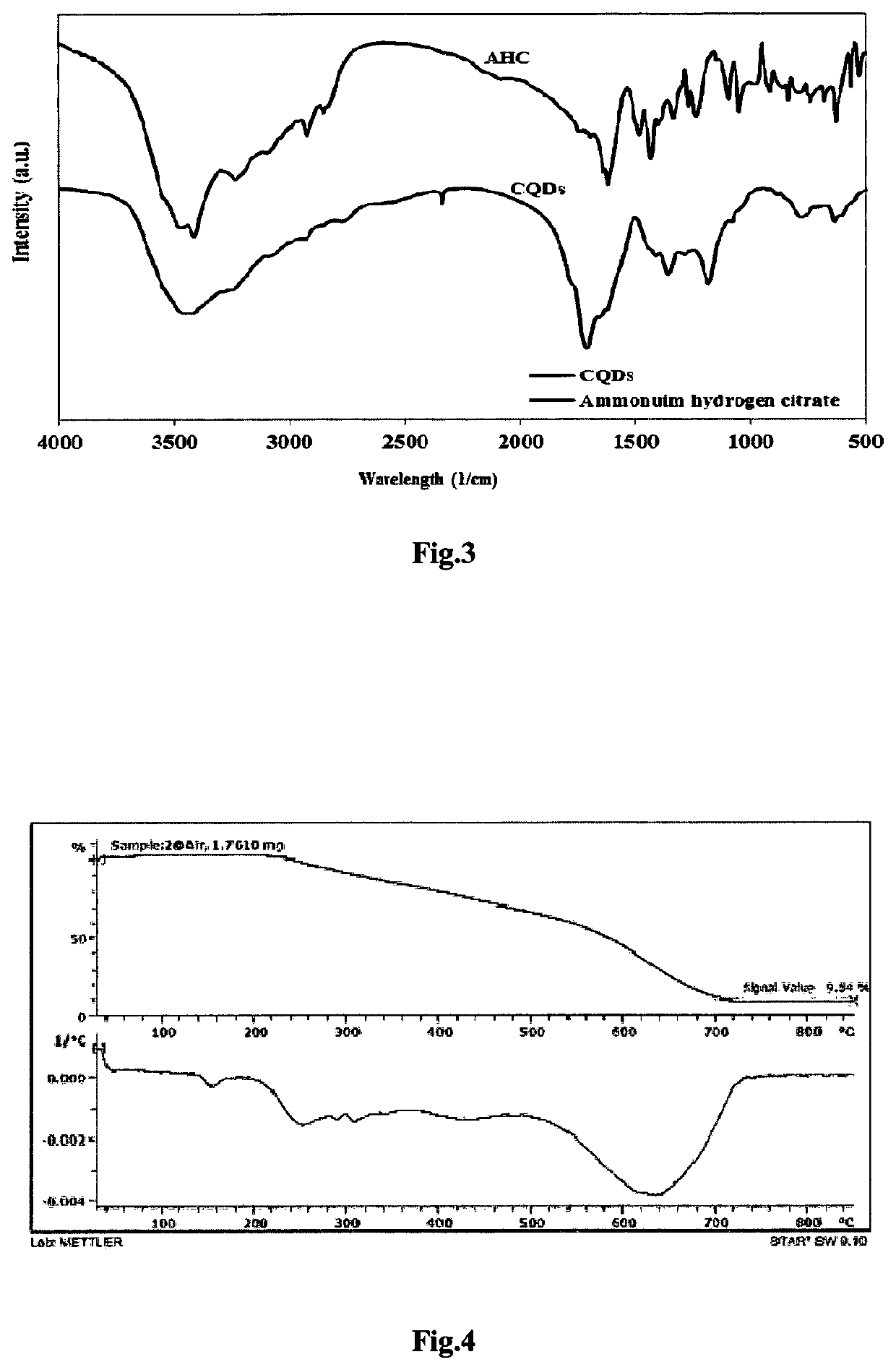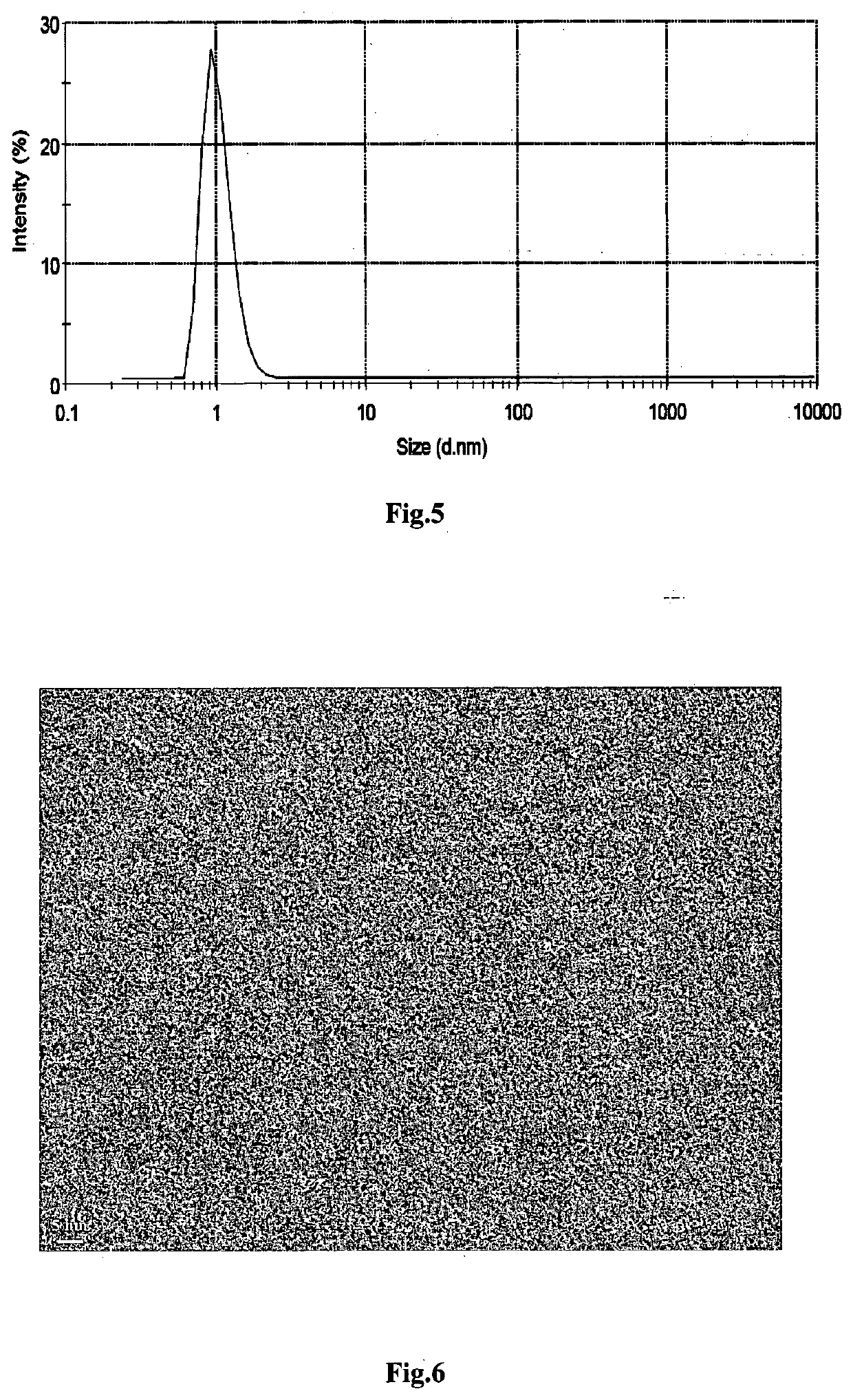Formulation for the synthesis of thermal nanofluid based on carbon nanodots
a carbon nanodot and thermal nanofluid technology, applied in the field of nano-ofluids containing carbon nanodots, can solve the problems of less efficiency relative to chemical methods, more complex synthesis stages of physical methods,
- Summary
- Abstract
- Description
- Claims
- Application Information
AI Technical Summary
Benefits of technology
Problems solved by technology
Method used
Image
Examples
example 2
N OF QUANTUM DOTS BY THERMAL REFLUX METHOD
[0074]In this method, 1-5 grams of the initial precursor (ammonium hydrogen citrate) was fully dissolved in 10-20 grams of deionized water and was exposed to air flow by the use of a condenser and a three-necked flask. The reaction temperature was controlled at a rate of 15° C. / min within the range of 160-220° C. With the passage of time, the solution turned from colorless to light yellow showing the formation of carbon quantum dots. Then, the solution was cooled up to the ambient temperature. Ultimately, the obtained solution was transferred to the rotary evaporator and after full evaporation of the solvent, the product was collected and fully dried in a vacuum oven. For every 2 grams of the initial precursor, about 1 gram of carbon quantum dot (CQD) was obtained.
example 3
N OF CARBON QUANTUM DOTS BY MICROWAVE METHOD
[0075]According to one embodiment of the present invention, 1-5 grams of the initial precursor (ammonium hydrogen citrate) was fully dissolved in 10-20 grams of deionized water and then the suspension was exposed to microwave within the temperature range of 160-220° C. After the completion of the reaction time, the dried product was cooled up to the ambient temperature and then collected from the reaction vessel. The yield of this method was better than the hydrothermal method and for every 2 grams of the initial precursor, about 1.65 grams of carbon quantum dot was obtained. As it is observed, the highest yield pertains to the microwave method. The yield of hydrothermal and thermal reflux methods is almost close to each other and with regard to the simplicity of thermal reflux and very short reaction time, the thermal reflux method is of higher priority relative to hydrothermal method. On the whole, the microwave method is more desirable ...
example 4
ON OF NANOFLUID
[0080]The carbon nanoparticles quantum dots obtained from example 3 were used to prepare nanofluid samples. 0.005-0.1 percent by weight of nanofluids, the carbon quantum dots was added to the base fluid (water or ethyl glycol (ex. 6 and 10)) and the container of the sample was placed in an ultrasonic bath at room temperature (25° C.) with a frequency of 37 kHz for only 15 minutes to stabilize the nanoparticles and no chemical surfactant and / or other additives were used for the preparation of the samples. Furthermore, in order to study the stability of nanoparticles in water, the z-potential test was used. As it is observed in FIG. 9, the zeta value is about −38.8 my representing its very high stability rate. Also, the negative values of zeta potential display the formation of amine groups which contribute to suspension stability. The nanofluids prepared by this method enjoy a very high stability and at least no precipitation and change of state have been observed for ...
PUM
| Property | Measurement | Unit |
|---|---|---|
| particle size | aaaaa | aaaaa |
| size | aaaaa | aaaaa |
| size | aaaaa | aaaaa |
Abstract
Description
Claims
Application Information
 Login to View More
Login to View More - R&D
- Intellectual Property
- Life Sciences
- Materials
- Tech Scout
- Unparalleled Data Quality
- Higher Quality Content
- 60% Fewer Hallucinations
Browse by: Latest US Patents, China's latest patents, Technical Efficacy Thesaurus, Application Domain, Technology Topic, Popular Technical Reports.
© 2025 PatSnap. All rights reserved.Legal|Privacy policy|Modern Slavery Act Transparency Statement|Sitemap|About US| Contact US: help@patsnap.com



